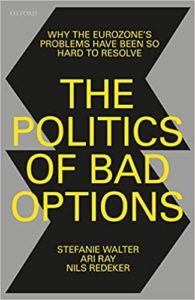Public Choice and Statecraft in the Euro Crisis
By Nils Karlson


- Book Review of The Politics of Bad Options: Why the Eurozone’s Problems Have Been Hard to Resolve, by Stefanie Walter, Ari Ray, and Nils Redeker.1
However, according to many economists, the institutional structure behind the euro was flawed or incomplete from the beginning, for two major reasons. The first is that the countries making up the euro area simply are too diverse. According to Nobel laureate Robert Mundell, a well-functioning currency area, with a common central bank establishing the same interest rate and without the ability for the participating countries to adjust their exchange rates to make their goods cheaper and more attractive, needs to be an area with internal factor mobility and external factor immobility. The implication is that the markets of the euro area needed to be fully integrated, and the participating countries needed to face similar challenges in situations of macroeconomic external shocks. None of this was true when the Euro and the European Central Bank (ECB) were introduced, in the early 1990s, and it became even less true when additional countries joined the monetary union.
The second reason why the Euro was considered to have fundamental problems was that a monetary union most likely presupposes a political union, with common fiscal and social policies. Without deeper integration a common currency could not work, many economists argued; the statements concerning convergence criteria about budget deficits and public debt were simply not enough. However, the electorates in most EU member states do not want a stronger political union, as the referenda in both France and the Netherlands in 2005 showed.
It was the shock waves from the global financial crisis in 2008-2009, however, that served as a trigger and catalyst for a major debt and balance-of-payment crisis in the Eurozone. Major macroeconomic imbalances had developed in several countries in the Eurozone with slow growth, increasing public and private debt, and increasing unit labor costs. The causes were as always varied and complex, but one major reason was no doubt the low interest rates, easy credit, and capital inflows to current account deficit countries made possible by the common currency and the European Central Bank (ECB). With the exchange rate fixed, the only available adjustment mechanism was painful internal devaluation, something that few governments could endure. To avoid a feared meltdown when the credit worthiness of member states such as Cyprus, Greece, Ireland, Portugal, and Spain were reassessed, the euro group agreed on a bank rescue plan, where governments would support the banks and guarantee interbank lending. Moreover, with the risk of a default in Greece and other Euro members in late 2009-10, provisions for bailing out member states who could not raise funds were agreed upon. This was done even though the European Union’s basic treaties rule out any bailout of a Euro member, to encourage them to manage their finances better.
In a new book by Stefanie Walter, Ari Ray, and Nils Redeker, The Politics of Bad Options: Why the Eurozone’s Problems Have Been So Hard to Resolve (Oxford University Press 2020), the authors argue that the costs of resolution in the Eurozone crisis were borne almost exclusively by indebted deficit countries, whereas the creditor-surplus states did little to share the burden. While debtor states were forced to implement austerity measures and structural reforms that were almost unprecedented in scale, surplus countries—their argument goes—did not significantly adjust their economic policies.
The purpose of the book is to explain this by examining the politics surrounding the choice of crisis strategies in both debtor-deficit and creditor-surplus countries. It is an impressive original work of public choice they present, based on macro-level statistical data, comparative case studies and detailed survey data from about 700 European interest groups about their preferences of policy options and the trade-offs between them. They focus on three broad strategies: Internal adjustment, external adjustment, and financing (such as bailouts or debt relief).
In summary, they show that distributive concerns—both within countries and among countries—shaped the politics of Eurozone crisis resolution. Within deficit-debtor and surplus-creditor countries, interest groups and voters fought to shift the costs of crisis resolution away from themselves. Creditor countries with current account surpluses fought with debtor countries with current account deficits over who should implement the policies necessary to reduce the current and capital account imbalances and who should take responsibility for the accumulated debts.
Most interesting is that two of the policy options did not materialize:
- (1) external adjustment in terms of a breakup of the Eurozone by one or several countries leaving; and
- (2) internal adjustment in the surplus countries through Keynesian policies of boosting demand and inflation, an option that the authors themselves explicitly favor.
But also,
- (3) financing policies of debt relief and bailouts, policies that were strongly opposed by the voters in the surplus countries,
nevertheless became an important part of the rescue package.
In (1), however, the surveys among interest groups in the deficit countries of Ireland, Spain and Greece clearly show that the interest groups became much more accommodative of the prospect of austerity and structural reform when they were confronted with the trade-off between internal adjustment and leaving the Eurozone. To have the common currency and benefit from the low interest rates guaranteed by the ECB apparently was considered very valuable. So much for the rhetoric and protests against austerity and long-needed structural reforms, reforms that in many cases actually have been implemented. In Spain, for example, a major labor-market reform became possible.
In (2) the electorate and interest groups in surplus countries like Austria, Germany, and the Netherlands were strongly divided towards expansionary policies to boost internal demand through public investments and welfare spending. The reasons proposed by the authors are two: the dominance of ordo-liberal ideas and strong interests that feared that export-led growth models could be undermined by such Keynesian measures. However, equally important in my view were the hard-won lessons that the surplus countries themselves had learned in the decades before the Eurozone crises. Germany, for example, used to be called “the sick man of Europe” as late as the year 2000 due to sluggish growth, high unemployment, and public deficits.
But the interest groups, voters, and taxpayers in the surplus countries also strongly disliked (3), the policies of debt relief and bailouts. As a consequence, the politicians and bureaucrats involved in crisis management had to frame their decisions around what was “politically possible without evoking resistance from a watchful public,” as attested by interviews conducted for the book. The policymakers resolved this problem by devising financing in a way that not only pushed the costs for taxpayers into the future, but also via indirect measures such as allowing the balances in creditors states’ central banks to grow. Moreover, they subjected the bailouts to significant conditionality.
Also, as mentioned above, policymakers and bureaucrats shifted the responsibility to the European level by introducing a bank rescue plan and provisions for bailing out member states, which was in fact forbidden in the EU treaties. Famously, ECB president Mario Draghi in July 2012 stated that the bank stood ready to do “whatever it takes to preserve the euro,” as the bank unveiled a new bond-purchasing program. In the process of this successful Machiavellian manoeuvre of “obfuscation,” the politicians in the surplus countries at the same time managed to save their own domestic banks which had been the main lenders to the credit countries.
Overall, in my view this combined policy of debt relief, bailouts, strict conditions of austerity measures and structural reforms in credit countries is a good example of statecraft: it saved the Eurozone from breaking up, it promoted necessary reforms in the creditor countries, and it managed to keep the costs for surplus countries at reasonable levels. In this regard I disagree with the authors of The Politics of Bad Options. It is not unique for the handling of the Eurozone crisis that all policy options have their pros and cons, and that tradeoffs must be made between them. This is the essence of politics in general.
Also, I think it is problematic to blame, as they do, the rise of populism and Eurosceptic parties across the EU on the austerity policies used to handle the Eurozone crisis. Populism started much earlier, especially in Southern Europe, and can well be considered a major cause to the questionable policies in the debtor countries in the decades before the crisis that others had to help to solve. In fact, those countries could no doubt benefit from a dose of “ordo-liberal” ideas.
But apart from this, The Politics of Bad Options: Why the Eurozone’s Problems Have Been So Hard to Resolve is an interesting, well-researched, and thought-provoking book of real-world public choice that is well-worth reading. Given that the underlying problems of the Eurozone still are far away from being solved, we can surely look forward to upcoming crises in the future.
Footnotes
[1] The Politics of Bad Options: Why the Eurozone’s Problems Have Been Hard to Resolve, by Stefanie Walter, Ari Ray, and Nils Redeker.
* Nils Karlson is Professor of Political Science and President of the Ratio Institute, Stockholm, Sweden.
